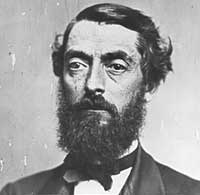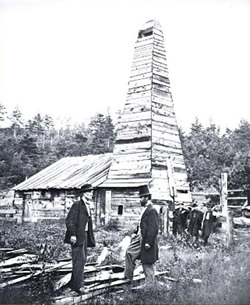
In 1959, Parke Dickey wrote in his article, "The First Oil Well," "No one is likely to question the fact that it was the Drake Well at Titusville which started the [oil] industry on its spectacular career…"
Edwin Drake was the first person to strike oil in America. His world-famous well was drilled in Titusville, PA, a small town in Crawford County. His innovative method of drilling for oil using an iron pipe not only caused a "black gold rush" but also placed him in the books of oil industry history.
Edwin Drake was born on March 29, 1819 in Greenville, New York. His family later moved to Vermont, which he left at age 19 and did odd jobs for 11 years. During that time, in 1845, Edwin Drake fell in love with and married Philena Adams, who died during child birth. In 1849, he got a job with the New York and New Haven Railroad where he would spend the next eight years. In 1857, Drake married his second wife, Laura Dowd—16 years his junior. Although much older, he was a loving husband who once wrote in a letter to her, "You know my love that I love you better than any and everything on Earth…" Drake was forced to retire from the railways shortly thereafter when he became ill with muscular neuralgia.
Prior to Drake striking black gold in Oil Creek near Titusville, other investors had tried profiting from the area, although none as successfully as Drake. Before Drake, others used the then-known methods of drilling for oil, which only caused setbacks and never led to marketable quantities of oil. For example, Samuel Kier, an important Pennsylvania figure, had tried to set up a refining enterprise in Pittsburgh but was kicked out by people who feared an explosion. One exception in Titusville was Hamilton McClintock, a farmer, who had the lower part of the creek on his property, where he would capture the oil seeping to the surface of the water. In one season, he could capture as much as 20 to 30 barrels. Investors consistently agreed on the importance of Titusville and its oil. McClintock's seepage caused great interest in the area; one agent purchased 100 acres of land for $5,000. The locals were astonished by the price of the "worthless land" where the oil constantly dirtied their shoes.
In the 1850's the excitement around oil and Titusville began to brew again and a group of chemists, lawyers, and others formed the first oil company in the United States, the Pennsylvania Rock Oil Company of New York, later renamed Seneca Oil Company of Connecticut. Drake was hired due to the sheer coincidence that he was out of work and staying at the same hotel as the founders of the company. His previous job with a railroad provided him with a free railway pass that worked in his favor. He took his family to Pennsylvania in hopes of finding an alternative to using whale oil for lamps. Drake did his initial reconnaissance of the area in December 1857 and returned again in 1858 with the title of "Colonel."

"Colonel" Drake faced difficulties from the beginning, the known methods of drilling for oil at the time only ended in failure. He spent five months trying to recover oil, and people had lost their trust in him and some began calling him "Crazy Drake." Even his primary driller, William"Uncle Billy" Smith, also began to feel dejected. Drake's biggest setback occurred on October 6, 1859 when the first oil well fire was started by "Uncle Billy," who went to inspect the oil in the vat with an open lamp, setting the gases alight. It burned the derrick, all the stored oil, and the driller's home. In the meantime, primitive methods only allowed Edwin Drake to drill 16 feet deep, neither deep enough to find oil, nor as deep as he was prepared to go: 1,000 feet.
In order to overcome the hurdles before him, he invented a "drive pipe" or "conductor," an invention he unfortunately did not patent. Accordingly to The Daily Picayune, "Mr. Drake conceived the idea of driving a pipe down to the rock through which to start the drill." "Uncle Billy" used Drake's invention, drilling an average of three feet per day through rock and shale. Although the "drive pipe" caused some problems, it paid off on August 27, 1859 when at a shallow 69.5 feet Drake struck black gold. By this time, Seneca Oil had abandoned Drake and his pursuits, refusing to help him out financially causing him to use his own money and when that had run out borrow from friends. It is estimated that his well produced between 20-40 barrels daily, using all the whiskey barrels in Titusville. In fact, Western Pennsylvania produced half of the world's oil until the East Texas oil boom in 1901. John Wesley Owen wrote in 1975, in his volume, Trek of the Oil Finders, "The inception of the modern petroleum industry can be fairly said to have occurred at Oil Creek…" And Edward Chancellor of the Financial Times wrote in 2008, "In a few days, Drake extracted as many barrels of oil as a whaling ship could gather on a four-year voyage." Drake proceeded to dig two other wells in the 1860s. By 1876, the well had stopped producing oil. Also despite Drake's success, Seneca did not reimburse him for his first well until four years after the fact.

After leaving the industry, he became a Justice of the Peace in 1860 but, due to his atrophying muscles, left shortly thereafter. In 1863, "Colonel" Drake and his family left Pennsylvania only to endure more financial setbacks and later returned without money and with Drake in crumbling health. The caring residents of Titusville started a collection for him in 1870 and convinced the General Assembly in 1873 to provide Drake's family with an annual pension of $1,500.
Drake died in Bethlehem, PA on November 9, 1880, and was later moved to Titusville, where he remains today. In 1902, Henry Rogers, a Standard Oil Executive, built a statue of Drake at his burial site. The original tools that Drake used for Oil Creek Well can be found at the Drake Well Museum in Titusville.
Sources:
- Bowling, Brian. “Boom and bust for first oil well driller Edwin Drake.” Pittsburgh Tribune-Review 6 July 2008. <http://www.pittsburghlive.com/x/pittsburghtrib/news/specialreports/250-a....
- Chancellor, Edward. “Whale of a future for oil industry.” Financial Times [London, UK] 2 June 2008: 32.
- Dickey, Parke A. “The First oil well.” Oil Industry Centennial: Journal of Petroleum Technology (January 1959), 59, 14-25.
- Drake Well Museum. Pamphlet: “The Drake Family.” 2001. Printed by: Pennsylvania Historical and Museum Commission.
- “Edwin Drake.” Who Made America? 2004. PBS. 7 July 2008 <http://www.pbs.org/wgbh/theymadeamerica/whomade/drake_hi.html>.
- “Independents Build an Industry.” Oil & Gas Investor. July 2004: 22.
- Krakosky, Norah. “Drake’s Oil Well.” Pittsburgh Post - Gazette 13 Sep. 2007: F.7.
- Owen, Edgar Wesley. Trek of the Oil Finders: A History of Exploration for Petroleum. Tulsa, OK: American Association of Petroleum Geologists, 1975.
- Pees, Samuel T. “The Drake Chapters.” Oil History. 2 June 2004. Petroleum History Institute. 7 July 2008 <http://www.petroleumhistory.org/OilHistory/pages/drake/drake.html>.
- “The First Man to Strike Oil.” St. Louis Globe-Democrat. 5 Oct. 1879: 11.
- “Who Drilled the First Oil Well?” The New Orleans Daily Picayune. 17 Apr. 1887: 10.
